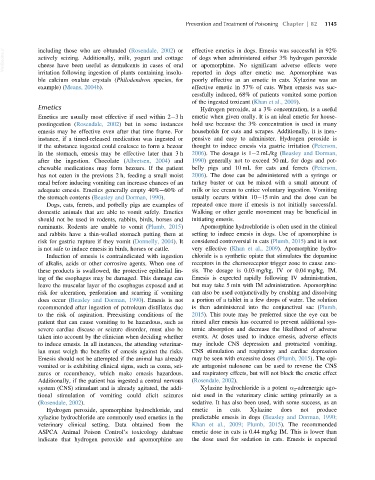Page 1214 - Veterinary Toxicology, Basic and Clinical Principles, 3rd Edition
P. 1214
Prevention and Treatment of Poisoning Chapter | 82 1145
VetBooks.ir including those who are obtunded (Rosendale, 2002)or effective emetics in dogs. Emesis was successful in 92%
of dogs when administered either 3% hydrogen peroxide
actively seizing. Additionally, milk, yogurt and cottage
or apomorphine. No significant adverse effects were
cheese have been useful as demulcents in cases of oral
irritation following ingestion of plants containing insolu- reported in dogs after emetic use. Apomorphine was
ble calcium oxalate crystals (Philodendron species, for poorly effective as an emetic in cats. Xylazine was an
example) (Means, 2004b). effective emetic in 57% of cats. When emesis was suc-
cessfully induced, 68% of patients vomited some portion
of the ingested toxicant (Khan et al., 2009).
Emetics Hydrogen peroxide, at a 3% concentration, is a useful
Emetics are usually most effective if used within 2 3h emetic when given orally. It is an ideal emetic for house-
postingestion (Rosendale, 2002) but in some instances hold use because the 3% concentration is used in many
emesis may be effective even after that time frame. For households for cuts and scrapes. Additionally, it is inex-
instance, if a timed-released medication was ingested or pensive and easy to administer. Hydrogen peroxide is
if the substance ingested could coalesce to form a bezoar thought to induce emesis via gastric irritation (Peterson,
in the stomach, emesis may be effective later than 3 h 2006). The dosage is 1 2 mL/kg (Beasley and Dorman,
after the ingestion. Chocolate (Albretsen, 2004) and 1990) generally not to exceed 50 mL for dogs and pot-
chewable medications may form bezoars. If the patient belly pigs and 10 mL for cats and ferrets (Peterson,
has not eaten in the previous 2 h, feeding a small moist 2006). The dose can be administered with a syringe or
meal before inducing vomiting can increase chances of an turkey baster or can be mixed with a small amount of
adequate emesis. Emetics generally empty 40% 60% of milk or ice cream to entice voluntary ingestion. Vomiting
the stomach contents (Beasley and Dorman, 1990). usually occurs within 10 15 min and the dose can be
Dogs, cats, ferrets, and potbelly pigs are examples of repeated once more if emesis is not initially successful.
domestic animals that are able to vomit safely. Emetics Walking or other gentle movement may be beneficial in
should not be used in rodents, rabbits, birds, horses and initiating emesis.
ruminants. Rodents are unable to vomit (Plumb, 2015) Apomorphine hydrochloride is often used in the clinical
and rabbits have a thin-walled stomach putting them at setting to induce emesis in dogs. Use of apomorphine is
risk for gastric rupture if they vomit (Donnelly, 2004). It considered controversial in cats (Plumb, 2015) and it is not
is not safe to induce emesis in birds, horses or cattle. very effective (Khan et al., 2009). Apomorphine hydro-
Induction of emesis is contraindicated with ingestion chloride is a synthetic opiate that stimulates the dopamine
of alkalis, acids or other corrosive agents. When one of receptors in the chemoreceptor trigger zone to cause eme-
these products is swallowed, the protective epithelial lin- sis. The dosage is 0.03 mg/kg, IV or 0.04 mg/kg, IM.
ing of the esophagus may be damaged. This damage can Emesis is expected rapidly following IV administration,
leave the muscular layer of the esophagus exposed and at but may take 5 min with IM administration. Apomorphine
risk for ulceration, perforation and scarring if vomiting can also be used conjunctivally by crushing and dissolving
does occur (Beasley and Dorman, 1990). Emesis is not a portion of a tablet in a few drops of water. The solution
recommended after ingestion of petroleum distillates due is then administered into the conjunctival sac (Plumb,
to the risk of aspiration. Preexisting conditions of the 2015). This route may be preferred since the eye can be
patient that can cause vomiting to be hazardous, such as rinsed after emesis has occurred to prevent additional sys-
severe cardiac disease or seizure disorder, must also be temic absorption and decrease the likelihood of adverse
taken into account by the clinician when deciding whether events. At doses used to induce emesis, adverse effects
to induce emesis. In all instances, the attending veterinar- may include CNS depression and protracted vomiting.
ian must weigh the benefits of emesis against the risks. CNS stimulation and respiratory and cardiac depression
Emesis should not be attempted if the animal has already may be seen with excessive doses (Plumb, 2015). The opi-
vomited or is exhibiting clinical signs, such as coma, sei- ate antagonist naloxone can be used to reverse the CNS
zures or recumbency, which make emesis hazardous. and respiratory effects, but will not block the emetic effect
Additionally, if the patient has ingested a central nervous (Rosendale, 2002).
system (CNS) stimulant and is already agitated, the addi- Xylazine hydrochloride is a potent α 2 -adrenergic ago-
tional stimulation of vomiting could elicit seizures nist used in the veterinary clinic setting primarily as a
(Rosendale, 2002). sedative. It has also been used, with some success, as an
Hydrogen peroxide, apomorphine hydrochloride, and emetic in cats. Xylazine does not produce
xylazine hydrochloride are commonly used emetics in the predictable emesis in dogs (Beasley and Dorman, 1990;
veterinary clinical setting. Data obtained from the Khan et al., 2009; Plumb, 2015). The recommended
ASPCA Animal Poison Control’s toxicology database emetic dose in cats is 0.44 mg/kg IM. This is lower than
indicate that hydrogen peroxide and apomorphine are the dose used for sedation in cats. Emesis is expected

